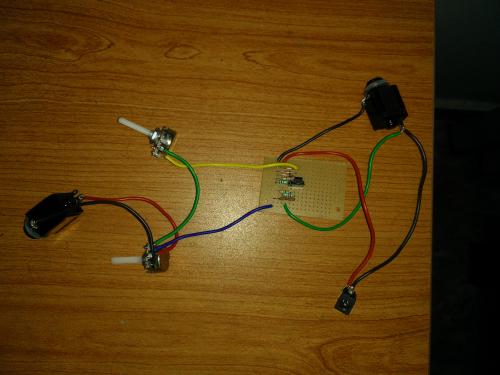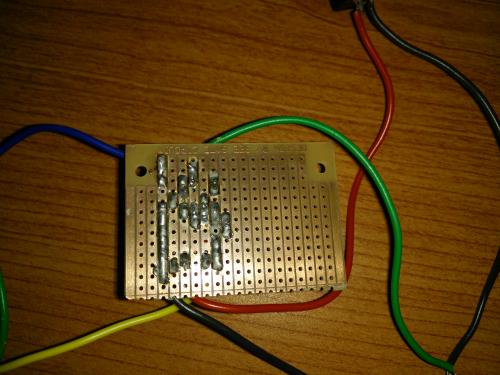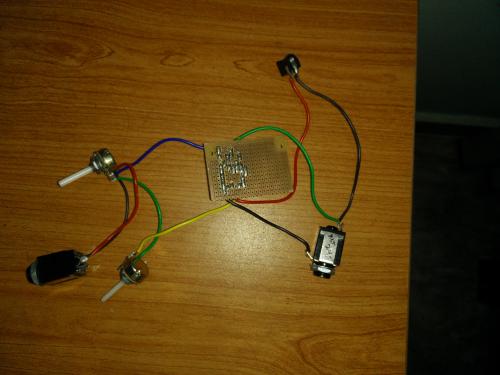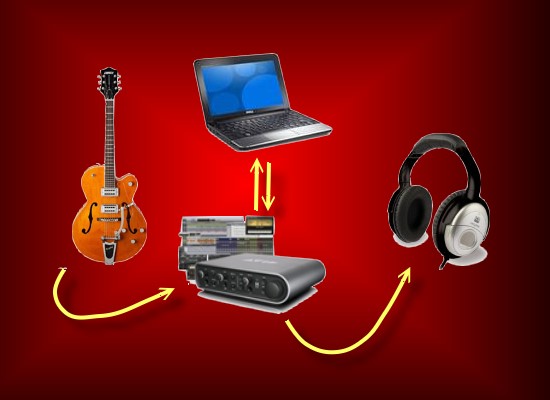Noise how do I get rid of it?
|
So I made 2 pedals today,the first one(my first pedal)..was a krank distortus maximus...I added a true bypass dpdt switch to it..and it was too noisy..I blamed it on my soldering and went for something easier and made a Nick Greer Green giant(without a bypass)..well Its the same problem..the noise..its so loud that I cant even hear my guitar, to be quite honest I am not sure that the circuit is even taking the input from the guitar...but I've checked for continuity and voltages across the components..and it all works fine..the noise increases with the increase in volume..so the volume pot works..shouldnt that imply that the effect works too?...even in the krank distortus maximus each pot used to create some difference in the noise...when rotated..how do I eliminate this noise...can someone please help?
|
|
Check all of your ground connections, as this sounds like a classic grounding problem. Also, some pictures of your vero boards would help. Thanks!
|
|
In reply to this post by Devilidol
I will take a wild guess that it is your grounding. It is VERY important that all grounds are connected together. There are several good grounding schemes online, but this one has helped me the most because it is big and easy to read:
http://www.madbeanpedals.com/tutorials/downloads/StandardWiring_MBP.pdf Remember to ground your circuit to everything else, and also your guitar jacks in and out. there are different ways to do it (sequentially) and it doesn;t make any difference. I usually ground the circuit board to one of the guitar cable jacks (I often tie both jack's grounds together), because it is close by, then I carry that to the main DC ground input, then the footswitch for example. Everything that is grounded needs to be connected to everything else that is grounded - including the DC ground input. The one thing yo can leave out (for simplicity, especially at first) is the battery connector, assuming you have a DC 9v power supply. |
|
This post was updated on .
In reply to this post by Devilidol
Hi Devilidol, and welcome!
As Frank says, photos would be a huge help, in order for us to help you out. If you could take a photo of both the component side, and especially the solder side (post them back up here), we can have a look to see if you have any errors. Don't forget to show your pot and jack connections if possible. Noise can be induced by power supplies, especially if they are not regulated, so I always test circuits with a battery first - even if I do not intend to use a battery in the finished pedal. I do not like using a power supply to do a first test on a circuit. You run a very real risk of burning out your power supply if you have made errors or have short circuits on your build. Once I have established that the circuit works as it should using battery power, I will only then swap to a power supply. |
|
In reply to this post by Frank_NH
Thanks for replying!...here are some pics! of the pedal!..i am definitely not very good at soldering :P
   <nabble_img <nabble_img
|
|
Try this. Get an alligator clip and connect the input jack ground to the output jack ground. Also - I don't see any power filtering! Try using a battery for now. Which circuit is this?
(edit - OK, it looks like the Nick Greer Green Giant. Power should be OK, but you can use a battery if you think the noise is in your 9V supply). |
|
In reply to this post by Devilidol
Thanks for the photos - it really helps.
The good news is that your solder joins look pretty neat and shiny to me, which is a good thing, and shows you are not as bad as you think. However, you may be using too much solder. Looking at the middle photo - the large image of the solder side of the board, it looks to me as though you may have bridged across rows in a couple of places, as a result of using too much solder. Use a magnifier to check whether this is actually the case. I you have got bridges, you can usually remove the excess by running the tip of your soldering iron slowly along the cut between the copper tracks. When you have what looks like a clear track, carefully "knife" along the track - you can use a knife to do this, a thin razor saw or hacksaw, or a needle file (my preferred tool for this is a triangular needle file). This removes any last trace of solder bridges. Lastly using a stiff brush (an old toothbrush is ideal), scrub the solder side of the board to remove any remaining solder particles and dirt. Check again with a magnifier to ensure the track cuts are completely clear. If they are, go ahead and test. |
|
In reply to this post by Frank_NH
The pics are a little dark, but I think I see a jack for a 9v power source. I don't see a complete ground circuit, though. You need to go from ground on the DC jack to the circuit board, then to one guitar jack, and then to the other. That is why you have noise.
I agree - make a few alligator clips and try connecting all possible ground points. This was my lifeline at first. |
|
Thanks a lot guys...I will surely try all the suggestion given
I am a lil confused with the complete ground circuit. and there are 2 grounds one coming from a potentiometer and the other from the board Right now the ground from the board is connected to the ground of the guitar jack then to the DC jack. And the ground from the potentiometer is connected to the ground of the other guitar jack? Is this not a complete ground circuit? |
Re: Noise how do I get rid of it?
|
No. you'll have to join both the ground lugs on the in/out jacks. then it should work. the grounded lug on the pot isnt automatically at ground potential and needs to be grounded. by joining the grounds on both jacks it will be grounded. join the lug on the jack on the top right of the 1st pic with the green and black wires to the ground on the other jack.
|
|
OK...so I connected all the grounds.. And definitely the noise reduced then i soldered a 10uF electrolytic capacitor to the positive and ground of the DC jack and it removed the noise...as if the pedal works or not...I don't have an amplifier(its in my bands jam room) I thought if I'd connect the pedal in series with my processor i could run it through my speakers...well apparently that's not possible( stop laughing at how much of a noob i am)...if that's not the problem..then I have no idea what to do next ...Ill probably try it with my friends amp in the evening and then give the final verdict...fingers crossed....thanks a lot who helped me...I learnt a lot..now when I make my next pedal..I know what I should look for..
|
|
Ideally you should have an audio interface to play guitar through your computer
 But if you have a basic 1/4" to mini-plug adapter you can probably connect the pedal to your mic input on your computer (I have done it before). It is not recommended as the best way to go, but it does work. You might have to pad down the input level on your computer sound card. But if you are going to get into pedal making, either get some kind of recording interface, or just a small amp like a Roland cube, or (even better) a small tube amp like at least a Fender Champ. Ideally, you will want to know what your pedal sounds like through your regular playing gear, but a small amp is pretty necessary for testing when you are building. |
|
So I finally made one more nick Greer green giant with film capacitors ..and it worked....I'd like to thank everybody who helped me...now I know I can build pedals...thanks a lot...it feels great when you put so much effort and it finally works....thanks a lot guys. .
|
«
Return to Open Chat
|
1 view|%1 views
| Free forum by Nabble | Edit this page |

